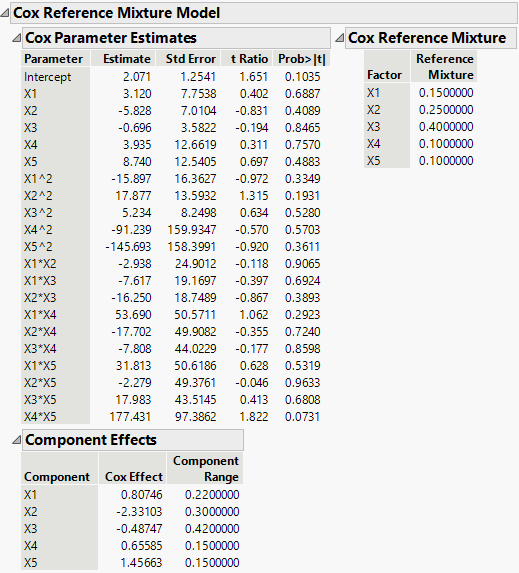Cox Mixtures
Note: This option is available only for mixture models.
Standard least squares fits mixture models using the parameterization suggested in Scheffé (1958). The parameters for this model cannot easily be used to judge the effects of the mixture components. The Cox Mixture model is a reparameterized and constrained version of the Scheffé model. Using its parameter estimates, you can derive factor effects and the response surface shape relative to a reference point in the design space. See Cornell (1990) for a complete discussion.
The Cox Mixture option opens a window where you enter the reference mixture. If you enter components for the reference mixture that do not sum to one, then the components are proportionately scaled so that they do sum to one. The rescaled mixture is shown in the report as the Reference Mixture. The component effects also appear in the report. A Cox component effect is the difference in the predicted response as the factor goes from its minimum to maximum values along the Cox effect direction.
Example of Cox Mixtures
1. Select Help > Sample Data Library and open Five Factor Mixture.jmp.
2. Select Analyze > Fit Model.
3. Select Y1 and click Y.
4. Select X1 through X5.
5. Select Macros > Mixture Response Surface.
6. Click Run.
7. Click the Response Y1 red triangle and select Estimates > Cox Mixtures.
8. In the Reference Mixture specification window, enter the following values:
– Next to X1, type 0.15.
– Next to X2, type 0.25.
– Next to X3, type 0.4.
– Next to X4, type 0.1.
– Next to X5, type 0.1.
9. Click OK.
Figure 3.39 Cox Mixtures
The report shows the parameter estimates for the Cox mixture model, along with standard errors and hypothesis tests. The reference mixture appears on the right. The component effects appear below, along with the component ranges.
